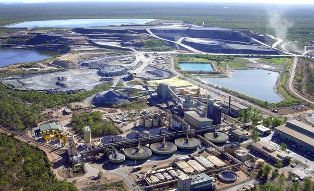Last year's uranium production was the highest since 2005, mainly thanks to the absence of the difficult weather conditions that have hampered work in recent years.
The total figure for Australia in the financial year 2008 was 10,277.8 tonnes of uranium oxide (8715 tonnes of uranium). This comprised 5678 tonnes at Ranger, 3974 tonnes at Olympic Dam, and 625.8 tonnes at Beverley.
Ranger had its second highest 12-month production ever. Here, the average grade increased from 0.26% uranium oxide in the first half of last year to 0.29% this year, and there was a slight increase in throughput. The new laterite processing plant contributed for the first time, and the new radiometric ore sorter is now online and will help maintain high-grade through the plant.
 |
| Ranger |
Mine production early this year was higher than last year mainly due to less rain and no wet season flooding. ERA's net profit after tax and its underlying earnings for the half year ended 30 June 2009 were both a record A$127.6 million ($107.2 million) compared with ERA's record full year underlying earnings in calendar 2008 of A$119.0 million ($99.9 million). Earnings before interest and tax were A$176.1 million for the half year ($147.9 million). The average realised sales price of uranium oxide for the six months to June 2009 was $48.02 per pound, up 35% on the year earlier.
At Olympic Dam, BHP Billiton had two weaker quarters of production, but the last quarter was among its best. Overall the twelve months was just average. Work continues on the feasibility study to increase copper and uranium production fourfold, and the comment period on the 4000-page draft environmental impact study for this has closed.
Beverley had its lowest full year's production so far, but Heathgate Resources expects greater mill throughput in 2010 due to the commencement of mining at the adjacent Four Mile deposit, of which Heathgate owns 75%. Loaded resin from a satellite ion exchange plant will be trucked from Four Mile to the main Beverley plant.
By mid 2010 the Four Mile mine is expected to be in production, and the smaller Honeymoon mine close to start-up.




_18570.jpg)
_16159.jpg)
_18938.jpg)
_33584.jpg)





